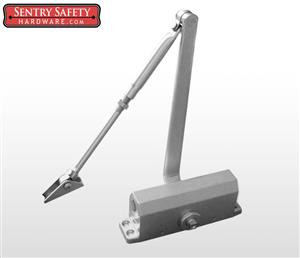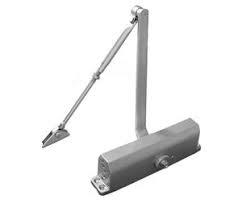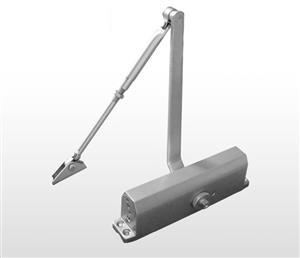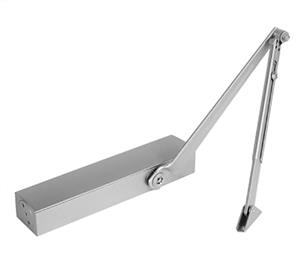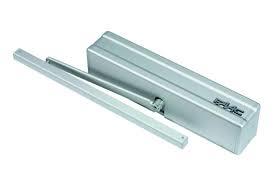Door closers are essential to anyone interested in controlling access to an commercial door. The way a door closer works is the door is opened and as such is done a spring is being wound. The wound spring will then try to unwind which is what closes the door however a hydraulic valve will control the speed in which it unwinds. Most imagine door closers simply as a device to ensure your door returns to the closed position. However they can add so much more that is both useful and limits possible accidents. Some of the options you can get are:
Backcheck: This will limit the degree of opening of the door. If you have a wall or table that the door continually gets opened and slammed into this is a way to use a door closer to protect the door from being slammed into things. Another use of backcheck is if the door gets pulled from your hands opening in the wind backcheck door closer will control it from slamming open.
Delayed Action: Delayed action is a pause in the open position. When the door closer is opened the door will stay open for a short period of time until it begins closing again. Ideal for doors that have handicapped access.
Closing speed, Latching speed and Adjustable Spring: The hydraulic valve is what controls the speed of closing. Door closers with 2 valves can have two different speeds. One for the primary swing travel of shutting and another for when the door meets the door frame to ensure a slow, safe closing. Additionally some door closers have adjustable springs that can control the amount of force the closer exerts on the door. This will help with heavier doors or doors that may have wind resistance.
Hold open bar: The hold open bar is an accessory that can be purchased with any of the door closers. Once the door is pushed open to a preset degree the arm will physically lock in the open position. To release the door so it can close, push on the door again and the door closer arm will release from the locked state. This is great for doors on warehouses that may need to be traveled through repeatedly with pallet jacks or trolley loads.
One more factor you will find in door closers are a universal sizing for closing force. The closing force is measured 30 inches from the hinges and the door opened 1/2 to 3 inches and allowed to close.
Size 1: 2lbs closing force, Size 2: 3lbs closing force, Size 3: 5lbs closing force, Size 4: 8lbs closing force, Size 5: 11lbs closing force, Size 6: 14lbs closing force
Door closers are essential to anyone interested in controlling access to an commercial door. The way a door closer works is the door is opened and as such is done a spring is being wound. The wound spring will then try to unwind which is what closes the door however a hydraulic valve will control the speed in which it unwinds. Most imagine door closers simply as a device to ensure your door returns to the closed position. However they can add so much more that is both useful and limits possible accidents. Some of the options you can get are:
Backcheck: This will limit the degree of opening of the door. If you have a wall or table that the door continually gets opened and slammed into this is a way to use a door closer to protect the door from being slammed into things. Another use of backcheck is if the door gets pulled from your hands opening in the wind backcheck door closer will control it from slamming open.
Delayed Action: Delayed action is a pause in the open position. When the door closer is opened the door will stay open for a short period of time until it begins closing again. Ideal for doors that have handicapped access.
Closing speed, Latching speed and Adjustable Spring: The hydraulic valve is what controls the speed of closing. Door closers with 2 valves can have two different speeds. One for the primary swing travel of shutting and another for when the door meets the door frame to ensure a slow, safe closing. Additionally some door closers have adjustable springs that can control the amount of force the closer exerts on the door. This will help with heavier doors or doors that may have wind resistance.
Hold open bar: The hold open bar is an accessory that can be purchased with any of the door closers. Once the door is pushed open to a preset degree the arm will physically lock in the open position. To release the door so it can close, push on the door again and the door closer arm will release from the locked state. This is great for doors on warehouses that may need to be traveled through repeatedly with pallet jacks or trolley loads.
One more factor you will find in door closers are a universal sizing for closing force. The closing force is measured 30 inches from the hinges and the door opened 1/2 to 3 inches and allowed to close.
Size 1: 2lbs closing force, Size 2: 3lbs closing force, Size 3: 5lbs closing force, Size 4: 8lbs closing force, Size 5: 11lbs closing force, Size 6: 14lbs closing force
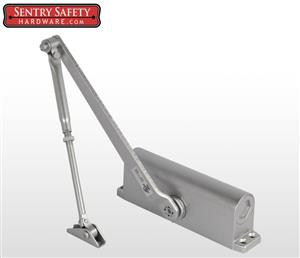 UL Listed/ANSI/BHMA Commercial and Residential Use Automatic Door Closer for Door Weights 99-143lbs by Sentry Safety
UL Listed/ANSI/BHMA Commercial and Residential Use Automatic Door Closer for Door Weights 99-143lbs by Sentry Safety
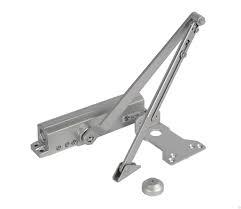 UL Listed/ANS Commercial and Residential Use Automatic Door Closer for Door Weights 55-187lbs by Sentry Safety
UL Listed/ANS Commercial and Residential Use Automatic Door Closer for Door Weights 55-187lbs by Sentry Safety
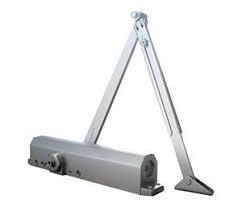 UL Listed/ANS Heavy Duty Commercial Automatic Door Closer for Door Weights 90-300lbs by Sentry Safety
UL Listed/ANS Heavy Duty Commercial Automatic Door Closer for Door Weights 90-300lbs by Sentry Safety




 0
0



